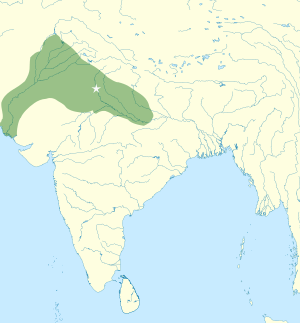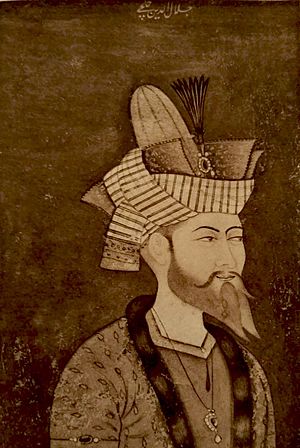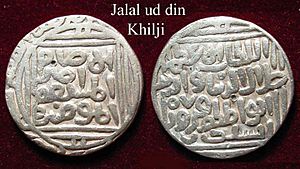Jalal-ud-din Khalji facts for kids
Quick facts for kids Jalal-ud-din Khaljiجلالالدین خلجی |
|
|---|---|
| Sultan | |
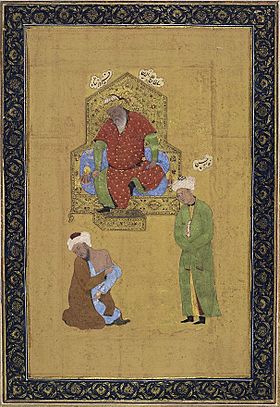
Portrait of Sultan Firuz Khalji (enthroned), Khwaja Hasan, and a dervish (c. 1640)
|
|
| 12th Sultan of Delhi | |
| Reign | 13 June 1290 – 19 July 1296 |
| Coronation | 13 June 1290 |
| Predecessor | Shamsuddin Kayumars |
| Successor | Alauddin Khalji |
| Born | c. 1220 Qalati Ghilji, Afghanistan |
| Died | 19 July 1296 Kara, India |
| Spouse | Malika-i-Jahan |
| Issue | Khan-i-Khan Mahmud Arkali Khan Ruknddin Ibrahim Qadr Khan Malika-i-Jahan (wife of Alauddin Khalji) |
| House | Khalji |
| Religion | Sunni Islam |
Jalal-ud-din Khalji (born around 1220, died 19 July 1296) was the first Sultan of the Khalji dynasty. This dynasty ruled the Delhi Sultanate from 1290 to 1320. He was also known as Firuz-Al-Din Khalji or Jalaluddin Khilji.
Jalal-ud-din, whose original name was Firuz, began his career as an officer in the Mamluk dynasty. He rose to an important position under Sultan Muizzuddin Qaiqabad. When Qaiqabad became very ill, some powerful nobles tried to make his young son, Shamsuddin Kayumars, the new Sultan. They also tried to kill Jalal-ud-din. Instead, Jalal-ud-din had those nobles killed and became the regent, meaning he ruled for the young Sultan. A few months later, he removed Kayumars from power and became the new Sultan himself.
As Sultan, he successfully pushed back a Mongol invasion. He even allowed many Mongols to live in India after they converted to Islam. He captured the towns of Mandawar and Jhain from the Chahamana king Hammira. However, he could not capture the main Chahamana capital, Ranthambore. During his rule, his nephew Ali Gurshasp led successful raids on Bhilsa in 1293 and Devagiri in 1296.
Jalal-ud-din was about 70 years old when he became Sultan. He was known for being a gentle, humble, and kind ruler to the public. For the first year of his reign, he ruled from Kilokhri. This was to avoid problems with the older Turkic nobles in Delhi, the capital city. Some nobles thought he was a weak ruler and tried to overthrow him several times, but they failed. He usually gave light punishments to those who rebelled. However, a religious leader named Sidi Maula was executed for supposedly planning to remove him from power. Jalal-ud-din was eventually murdered by his nephew, Ali Gurshasp, who then became the next Sultan, known as Alauddin Khalji.
Contents
Early Life and Rise to Power
Jalal-ud-din was part of the Khalaj tribe. This was a Turkic tribe that had moved from Turkistan and settled in Afghanistan for over 200 years.
Historians don't have many details about Jalal-ud-din's early life. He likely started serving the Delhi Sultanate during the rule of Sultan Balban. He gradually became an important commander in north-western India. His main base was in Samana.
Before becoming Sultan, Jalal-ud-din was known as Malik Firuz. He and his brother Shihabuddin (who was Alauddin Khalji's father) served Balban for many years. He rose to become the chief of the royal bodyguards. Later, he was made the governor of the border province of Samana. As governor, he showed great skill in fighting against Mongol invaders.
After Balban died in 1287, his grandson Muiz ud din Qaiqabad became Sultan. Qaiqabad was a weak ruler. His officer, Malik Nizamuddin, ran the government. After Nizamuddin was poisoned, Qaiqabad called Jalal-ud-din to Delhi. He gave him the title "Shaista Khan" and made him the head of the army ministry. He also made him governor of Baran.
By this time, Qaiqabad's health was failing. Two groups of nobles in Delhi were fighting for power. One group wanted to keep the old Turkic nobles in charge and keep Balban's family on the throne. The other group, led by Jalal-ud-din, supported the rise of new nobles.
Becoming Regent for Kayumars
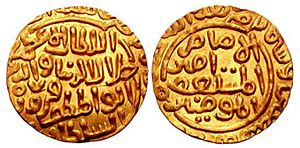
When Sultan Qaiqabad became very ill and couldn't recover, some nobles put his infant son, Kayumars, on the throne. These nobles then planned to kill their rivals, including Jalal-ud-din. Jalal-ud-din learned about this plot. He moved his camp and called his relatives from Baran. He said he was preparing for a Mongol invasion. Other officers who were also targeted by the plot joined Jalal-ud-din.
Jalal-ud-din was ordered to come to the royal court in Delhi. He realized this was a trap to kill him. He made an excuse that he was inspecting the army. One of the plotters, Kachhan, came to get him. Jalal-ud-din pretended not to know about the plot. He then had Kachhan killed, which started a conflict between the two groups.
Jalal-ud-din's sons marched to Delhi. They entered the palace and brought the young Sultan Kayumars to Jalal-ud-din's camp. The nobles who had plotted against Jalal-ud-din tried to get Kayumars back, but they were captured and killed. Jalal-ud-din's men also took some sons of the Delhi city chief. This stopped the people of Delhi from trying to get Kayumars back.
After removing his rivals, Jalal-ud-din still recognized Kayumars as the Sultan. He became the governor of several provinces. He offered to be Kayumars' regent, meaning he would rule on behalf of the young Sultan. He then became the regent himself.
Sultan Qaiqabad died on 1 February 1290. Some say he died from neglect, while others say he was murdered on Jalal-ud-din's orders. Kayumars ruled for about three months before Jalal-ud-din removed him from power.
Becoming Sultan
Jalal-ud-din became the Sultan of Delhi in June 1290. This happened at the unfinished Kilokhri Palace near Delhi. When he first became Sultan, many people did not like him. The old Turkic nobles saw him as an Afghan, wrongly thinking he was not of Turkic origin. Also, he was around 70 years old, and his kind nature was seen as not strong enough for a ruler. Because he was unpopular, he decided not to move into Balban's palace in Delhi. He lived at Kilokhri for about a year. He finished building the palace and made Kilokhri an important town.
Jalal-ud-din did not make big changes to the government. He kept the old Turkic nobles in their positions from Balban's time. For example, the chief of Delhi and the chief minister kept their jobs. Balban's nephew, Malik Chajju, remained governor of Kara-Manikpur.
At the same time, Jalal-ud-din gave important jobs to his relatives and friends. He made his brother the head of the army. His nephew, Ahmad Chap, also got a high position. His eldest son was given the title Khan-i-Khan. His other sons also received important titles. He also appointed his nephews Ali Gurshasp (who later became Sultan Alauddin) and Almas Beg to important court roles.
Slowly, Jalal-ud-din gained the trust of the people of Delhi. He became known as a humble and kind ruler, unlike the harsh rulers before him. When he finally entered Delhi, he showed his humility. He refused to sit on the king's main seat, saying that the crown had been forced upon him.
Malik Chajju's Revolt
Some nobles thought Jalal-ud-din was a weak ruler. In August 1290, Balban's nephew, Malik Chajju, who was now the head of the old royal family, started a rebellion against Jalal-ud-din in Kara. Chajju wanted to be far from the central government. He hoped to get support from his cousin, Bughra Khan, who had become an independent ruler in Bengal.
Chajju called himself Sultan Mughisuddin. He declared his independence. He even made his own coins and had his name read in public prayers. Other old nobles and many Hindu chiefs in the region supported him. Jalal-ud-din's loyal officers started to leave the area.
Chajju believed he had more support than Jalal-ud-din. He marched towards Delhi. His supporters joined him with their troops.
Jalal-ud-din left his eldest son in charge of Delhi and went to stop the revolt. His second son, Arkali Khan, led the first part of the army. They found Chajju's army across a river. Chajju's soldiers had taken all the boats. Arkali Khan sent a small group to raid Chajju's camp at night. This caused panic, and Chajju's soldiers fled north. Arkali Khan plundered the empty camp for two days, then chased the enemy. He fought a battle that didn't have a clear winner. Meanwhile, Jalal-ud-din's main army crossed the Ganges River and fought another battle with Chajju's supporters.
Chajju secretly left his camp with some followers. In the morning, Arkali Khan crossed the river and easily defeated the rest of Chajju's army. Some of Chajju's supporters were killed, and others were captured. The rest of Chajju's army surrendered. Chajju himself hid in a village, but the village leader handed him over to Jalal-ud-din's army.
Arkali Khan then joined Jalal-ud-din. The combined army marched to punish the chiefs who had supported Chajju. Some chiefs surrendered and paid large tributes. Others faced raids and their lands were plundered. Hindu rebels were executed. Muslim rebels of Indian origin were sold as slaves.
Jalal-ud-din treated the Turkic Muslim rebels kindly. His nephew, Ahmad Chhap, disagreed with this. When the captured nobles were brought in chains, Jalal-ud-din ordered them to be released. He had them dressed well and entertained. He invited high-ranking rebel nobles to a feast. Even Malik Chajju, who was captured later, was sent to a comfortable prison in Multan instead of being killed. His friends were released. Jalal-ud-din openly praised the rebels for their loyalty to their former master, Balban. When Ahmad Chhap questioned this kindness, Jalal-ud-din said he was not used to killing Muslims. He believed the pardoned nobles would be thankful and loyal to him.
Mongol Invasion
After Chajju's revolt, the Mongols invaded the north-west border of the Delhi Sultanate. This invasion was led by Abdullah, a grandson of Hulagu Khan.
Jalal-ud-din's son, Arkali Khan, governed the border provinces. Jalal-ud-din personally led an army to fight the invaders. The two armies met, and their advance groups had some small fights. The Delhi forces gained an advantage, and the Mongols agreed to leave. Jalal-ud-din even called Abdullah his son after friendly greetings.
A group of Mongols, led by Ulghu (another grandson of Hulagu), decided to become Muslims. They asked Jalal-ud-din for permission to settle in India. In the Delhi Sultanate, Mongols were often seen as criminals. Despite this, Jalal-ud-din accepted them. He allowed them to settle in the lower Ganges plain, near the Bengal border. He also gave these new settlers homes, money, and social status. These Mongols became known as "New Muslims."
Ranthambore Campaign
The Chahamana king Hammira-deva ruled a kingdom around Ranthambore. This area was south-west of Delhi. Hammira's expanding power threatened the Delhi Sultanate's borders. This led Jalal-ud-din to invade his kingdom.
Siege of Mandawar
Jalal-ud-din marched to the border of Hammira's kingdom. He first attacked the fortress of Mandawar. Mandawar had once been part of the Delhi Sultanate but was lost to the Chahamanas. Jalal-ud-din recaptured it in 1292. After this victory, he raided the surrounding countryside and took many cattle.
Jalal-ud-din's eldest son, Khan-i Khanan, died just before the Mandawar campaign.
Siege of Jhain
In 1291, Jalal-ud-din marched to Jhain. This town protected the way to the Chahamana capital, Ranthambore. A small group from the Delhi army defeated a Chahamana group. Jalal-ud-din then sent a larger force to attack the Jhain fort. When the attackers were close to the fort, a Chahamana army came out and fought them. The Delhi army won, and the Chahamana leader was killed. The invaders chased the retreating Chahamana soldiers across several rivers. The remaining Chahamana groups in Jhain left the fort and went to Ranthambore.
After this victory, the invaders plundered the area and destroyed the Jhain fort. Jalal-ud-din, who was against non-Islamic idols, broke them. However, he admired their carvings.
Siege of Ranthambore
After taking Jhain, Jalal-ud-din ordered his army to attack the Ranthambore Fort. This fort was on a steep hill and was known for being very strong. He ordered the building of siege engines, which are machines used to attack forts. However, he stopped the attack when he saw how many Muslim lives it would cost. He said he would not risk the life of a single Muslim for "ten such forts." His nephew, Ahmad Chap, disagreed. He said this would make the Hindus bolder. He told Jalal-ud-din to be like earlier Muslim kings who were pious but still acted like kings. But Jalal-ud-din argued that those kings ruled lands without "idolaters."
Conspiracies Against Jalal-ud-din
Conspiracy of Tajuddin Kuchi
Some of Jalal-ud-din's courtiers believed he was a weak king. They thought he couldn't make his people or enemies fear him enough. During the Ranthambore campaign, some of his close friends met. They talked about killing Jalal-ud-din and making Tajuddin the new king.
When Jalal-ud-din found out, he called the courtiers to a private meeting. Instead of punishing them, he shamed them. He dared them to kill him with his own sword. The courtiers asked for forgiveness. The meeting ended with drinks and poetry.
Alleged Conspiracy of Sidi Maula
Jalal-ud-din was usually very forgiving towards those who criticized him. He would only banish them for a year. The only time he gave harsher punishments was during the supposed conspiracy of Sidi Maula.
Sidi Maula was a religious leader from another country. He had a large religious center and was known for his charity. Many former officers from Balban's time followed him. Even Jalal-ud-din's nobles, including his now-deceased crown prince, were followers.
Sidi Maula was accused of planning to kill Jalal-ud-din to become the new ruler. These claims were never fully proven. It was said that Sidi Maula asked two Hindu officers from Balban's time to kill Jalal-ud-din. A Mongol commander, Malik Ulghu, who worked for Jalal-ud-din, reported these claims to Arkali Khan. Arkali Khan believed the claims and arrested the accused.
When Jalal-ud-din returned to Delhi, the accused were brought before him. They said they were innocent. Religious scholars could not find strong evidence against them. They suggested a trial by fire. When Jalal-ud-din became convinced they were guilty, he ordered the Hindu conspirators to be executed. He then banished the Muslim officers who followed Sidi Maula. Jalal-ud-din then turned to Sidi Maula. He became angry when Sidi Maula kept denying his involvement. An annoyed Jalal-ud-din asked a group of religious beggars to stab Sidi Maula. Arkali Khan later had the wounded Sidi Maula crushed by an elephant.
After Sidi Maula's execution, a severe dust storm occurred. Then, a drought followed because the seasonal rains failed. These conditions led to a terrible famine. Food prices became very high, and many people died. Sidi Maula's supporters believed these events proved his innocence.
Ali Gurshasp's Conspiracy
After removing Malik Chajju, Jalal-ud-din made his nephew Ali Gurshasp (who later became Sultan Alauddin Khalji) the governor of Kara. Ali's father had died when Ali was young. Jalal-ud-din had raised Ali and his brother Almas Beg (later Ulugh Khan). Jalal-ud-din had also married his daughters to Ali and Almas. Ali's home life was unhappy, as he did not get along with his wife or mother-in-law. He wanted to be independent from Jalal-ud-din's family. In Kara, Malik Chajju's former supporters encouraged him to overthrow Jalal-ud-din.
To get money for a coup against Jalal-ud-din, Ali raided Bhilsa in 1293. Bhilsa was a temple town that had been weakened by earlier invasions. From this raid, Ali got a lot of cattle and valuable metals. In Bhilsa, he learned about the great wealth of the southern Yadava kingdom and the routes to their capital, Devagiri. He cleverly gave the loot from Bhilsa to Jalal-ud-din to gain the Sultan's trust. But he kept quiet about the Yadava kingdom's wealth. Pleased with the treasure, Jalal-ud-din gave Ali a high army position. He also made Ali governor of Awadh in addition to Kara-Manikpur. He also allowed Ali to use extra tax money to hire more troops. This was for raiding other rich but poorly defended areas.
Over the next few years, Ali secretly planned a raid on Devagiri. In 1296, he set out for Devagiri with 8,000 horsemen. He left the administration of Kara to Alaul Mulk, who misled Jalal-ud-din's government about Ali's real destination. In Devagiri, Ali collected a huge amount of wealth. When Jalal-ud-din heard about Ali's success, he was happy about the prospect of a vast treasure. He went to Gwalior, hoping Ali would meet him there on his way to Kara. However, Ali marched directly to Kara. Jalal-ud-din's advisors told him to stop Ali at Kara. But Jalal-ud-din trusted his nephew and returned to Delhi. In Delhi, Ali's brother, Almas Beg, assured the Sultan that Ali was loyal.
After reaching Kara, Ali sent Jalal-ud-din a detailed report about the raid. He said he was worried that his enemies might have turned Jalal-ud-din against him. He asked for a signed letter of pardon, which Jalal-ud-din immediately sent. In Kara, Jalal-ud-din's messengers were surprised to see Ali's strong army and his plans to take the throne. Ali held them back and stopped them from sending messages to Delhi.
Assassination
In July 1296, Jalal-ud-din marched to Kara with a large army to meet Ali. This was during the holy month of Ramzan. He told his commander, Ahmad Chap, to take most of the army to Kara by land. Jalal-ud-din himself traveled down the Ganges River with 1,000 soldiers. When Jalal-ud-din's group got close to Kara, Ali sent Almas Beg to meet him. Almas Beg convinced Jalal-ud-din to leave his soldiers behind. He said their presence would scare Ali. Jalal-ud-din got into a boat with a few companions, who were told to remove their weapons. As they rode the boat, they saw Ali's armed troops along the riverbank. Almas told them these troops were there to give Jalal-ud-din a grand welcome. Jalal-ud-din complained that Ali had not come to greet him. But Almas convinced him of Ali's loyalty. He said Ali was busy preparing a display of the loot from Devagiri and a feast.
Jalal-ud-din was satisfied and continued his journey to Kara, reciting the Quran on the boat. When he landed at Kara, Ali's group greeted him. Ali bowed down at his feet. Jalal-ud-din lovingly raised Ali, kissed him, and gently scolded him for doubting his uncle's affection. At this moment, Ali signaled his follower, Muhammad Salim, who killed Jalal-ud-din. Ali then raised the royal canopy over his head and declared himself the new Sultan. His companions on the boat were also killed. Ahmad Chap's army retreated to Delhi.
According to the writer Amir Khusrau, Ali became Sultan (as Alauddin Khalji) on 19 July 1296.
Cultural Activities
Jalal-ud-din's courtier, Amir Khusrau, wrote a book called Miftah al-Futuh (1291). This book celebrated Jalal-ud-din's victories.


